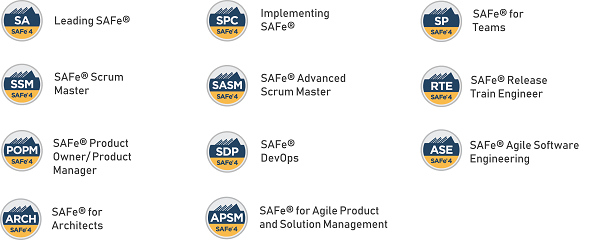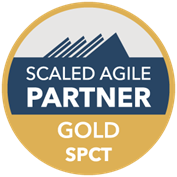A Total Overview to Earning Your SAFe DevOps Certification
A Total Overview to Earning Your SAFe DevOps Certification
Blog Article
Master Agile Practices Via Comprehensive SAFe Accreditation
In a progressively intricate organization landscape, mastering Nimble methods via extensive SAFe qualification has emerged as a vital expertise for professionals intending to improve business performance. This qualification not only gives a deep understanding of the SAFe structure but also cultivates important abilities for promoting collaboration and placement amongst teams. As organizations seek to navigate the difficulties of quick modification, the implementation of SAFe principles provides a path to boosted outcomes. The journey to accreditation includes even more than just academic expertise; it needs a critical approach to application that can dramatically affect service agility. What does this entail?
Understanding SAFe Structure
The SAFe (Scaled Agile Framework) framework acts as a structured approach for applying Nimble practices at scale throughout big organizations. It supplies an extensive approach that aligns the various degrees of an organization, from team to profile, guaranteeing that all parts work cohesively in the direction of typical goals. SAFe incorporates principles from Agile, Lean, and item advancement flow, providing a well-defined collection of duties, duties, and techniques.
At its core, the SAFe structure comprises 4 levels: Team, Program, Large Service, and Profile. Each degree addresses details elements of Agile delivery, from managing tiny groups of designers to supervising multiple programs and lining up strategic efforts with business goals.
SAFe motivates collaboration among cross-functional teams, cultivating an atmosphere where continuous enhancement and development are critical. SAFe DevOps certification. By stressing placement, transparency, and built-in quality, the framework gears up organizations to respond swiftly to market adjustments while supplying value to clients
Additionally, SAFe sustains numerous techniques, such as Scrum and Kanban, permitting companies to customize their strategy according to certain project requirements. This flexibility makes SAFe a durable structure for organizations intending to prosper in a quickly developing organization landscape.

Benefits of SAFe Accreditation
Frequently looked for after in the Agile area, SAFe certification provides various advantages for organizations and specialists alike. One of the key benefits is the improvement of skills and understanding in carrying out the Scaled Agile Structure (SAFe), which gears up people with the tools necessary to drive successful Agile improvements. This qualification signifies a dedication to specialist advancement, making prospects a lot more affordable in the job market.
For organizations, having accredited experts promotes a society of continual improvement and collaboration, important for adapting to transforming market needs. It enables groups to align their collaborate with calculated objectives, ultimately enhancing productivity and performance. Firms with a higher percentage of SAFe-certified employees usually experience minimized time-to-market and boosted top quality of deliverables.
Additionally, SAFe certification assists in networking chances with various other Agile professionals, allowing the exchange of best experiences and techniques (SAFe Agilist). This joint network can dramatically add to organizational and individual development. In summary, obtaining SAFe accreditation not just boosts individual abilities yet additionally strengthens the overall Agile maturation of an organization, leading to sustainable success in today's vibrant company setting
Key Parts of SAFe
Building on the advantages of SAFe certification, recognizing the key components of the Scaled Agile Structure is important for efficiently executing its principles. The SAFe structure comprises 4 main degrees: Team, Program, Big Option, and Profile. Each level addresses different facets of dexterous practices, helping with placement and shipment throughout the organization.
At the Group level, cross-functional groups function collaboratively making use of Nimble methodologies, such as Scrum or Kanban, to supply step-by-step value (SAFe Lean Portfolio Management). The Program level concentrates on the Agile Launch Train (ART), which is a long-lived team of Agile groups that prepares, devotes, and executes together. The Huge Solution degree addresses intricate services that call for several ARTs to work in show, making sure control and combination

Planning For SAFe Qualification
Preparing for SAFe qualification needs a calculated technique to guarantee an extensive understanding of the structure. First, acquaint yourself with the core concepts and values of the Scaled Agile Structure (SAFe) Review resources offered on the Scaled Agile website, consisting of the SAFe framework documents, study, and site web whitepapers, to build a solid structure.

In addition, technique with example exam questions to acquaint on your own with the layout and sorts of concerns you might experience. Joining study hall or online forums can facilitate understanding exchange and provide assistance from fellow prospects.
Using SAFe in Organizations
Carrying Out the Scaled Agile Framework (SAFe) within organizations necessitates a structured strategy that aligns teams and processes toward a typical goal. The effective application of SAFe starts with establishing a clear understanding of its concepts, including transparency, collaboration, and positioning. Organizations needs to first analyze their present processes and determine areas for enhancement, guaranteeing they await the cultural shift that SAFe involves.
Training and qualification for teams aid equip participants with the required abilities and knowledge to run efficiently within the SAFe framework. This includes developing Agile Launch Trains (ARTs), which offer as the foundation for providing worth across the organization.
Normal preparation sessions, such as Program Increment (PI) planning, must be performed to synchronize groups and focus on job. Furthermore, leveraging metrics to gauge progress and performance is essential for ongoing improvement. By continually applying SAFe concepts and practices, organizations can attain better dexterity, enhance cooperation, and ultimately drive better service outcomes. Embracing this framework settings organizations to react promptly to market changes and consumer demands.
Conclusion
Finally, mastering Agile methods through comprehensive SAFe certification significantly improves expert capabilities and contributes to a fantastic read business performance. The understanding acquired from recognizing the SAFe structure, in addition to its vital parts, boosts and assists in effective transformations cooperation among teams. Additionally, acquiring this accreditation positions individuals favorably in a competitive task market, underscoring the relevance of constant improvement and alignment within organizations. Welcoming SAFe ultimately causes increased efficiency and better deliverables.
The SAFe (Scaled Agile Framework) framework serves as an organized method for carrying out Nimble techniques at scale across large companies. One of the main advantages is the enhancement of skills and expertise in implementing the Scaled Agile Framework (SAFe), which furnishes people with the devices needed to drive successful Agile makeovers. In summary, obtaining SAFe certification not just improves private abilities yet likewise enhances the overall Agile maturity of an organization, leading to lasting success in today's dynamic service atmosphere.
Building on the benefits of SAFe qualification, comprehending the vital parts of the Scaled Agile Framework is essential for successfully implementing its concepts.Implementing the Scaled Agile Structure (SAFe) within companies requires an organized approach that straightens teams and procedures towards a typical objective.
Report this page